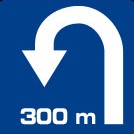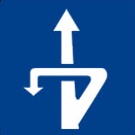Chapter 4: Maneuvers
4.1 Concept:
A manoeuvre is a notable variation in the moving vehicle such as:
- Merging
- Changing lanes
- Overtaking
- Changing direction
- Turning (including U-Turns)
- Stopping and parking
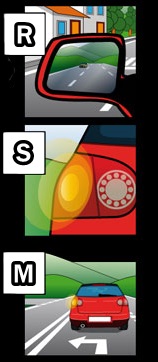
Safety Rule (M.S.M.):
M (Mirror, look),
S (Signal: with light signals or arm),
M (Manoeuvre)
Acoustic signals (horn):
Use outside of a built-up area:
- On narrow roads with many bends.
- To alert the driver in front that you are going to overtake.
Use in and out of a built-up area:
- To avoid a possible accident
- To warn that you are driving in case of a medical emergency
Arm signals:
Signs made with the arm will take precedence over light signals. However, our first choice to show our intention to make a manoeuvre is using light signals.
| Turning left | Turning right | Slowing down |
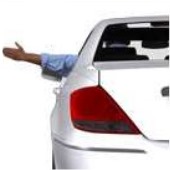 |
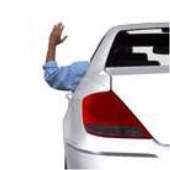 |
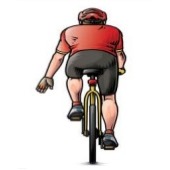 |
Merging with traffic:
When merging with traffic, you must drive at a speed that allows you to stop if you have to give way.
Other vehicles do not give way to the merging vehicle, but they should facilitate their merging.
4.2 Overtaking:
1. As a general rule: Overtaking is done on the left.
2. You can overtake on the right when:
- When a vehicle changes direction to the left, you can overtake on the right in and out of a built-up area.
- In a built-up area when there are 2 or more lanes for the same direction and they are marked.
- In a built-up area to overtake the trams travelling in the centre.
3. Lateral Space:
When overtaking IN A BUILT-UP AREA, you must leave a lateral space between you and the other vehicle, proportional to the speed and the width of the road.
When overtaking OUTSIDE of a built-up area, leave:
- A minimum of 1.5 metres for pedestrians, animals, or 2-wheel vehicles (bicycles, mopeds, etc.)
- A space proportional to the speed and width of the road for other vehicles
4. Obligations of a vehicle being overtaken:
- If there is no risk of accident:
- Do not increase or decrease your speed
- Drive near the right edge of the roadway without entering the hard shoulder
- If there is risk of accident, you must try to avoid it by:
- Increasing or decreasing your speed
- As a last resort, going off onto the hard shoulder
Note: Vehicles more than 3500kg may not deviate onto the hard shoulder or use the right turn indicator to facilitate overtaking.
5. Ways to warn that you are going to overtake:
a) To the vehicle behind you with the turn signal or arm.
b) To the vehicle ahead (in front of you):
- In a built-up area with short flashing of lights
- On inter-urban routes with flashing lights and horn
6. It is forbidden to overtake in:
a) Places of reduced visibility, except when lanes are marked with lines and overtaking is done without entering lanes of the opposite direction.
b) At level crossings and their vicinity, unless overtaking 2-wheeled vehicles.
c) In tunnels and underpasses if there is only one lane for the direction of the vehicle which is to be overtaken.
d) In pedestrian crossings and their vicinity, except:
- To overtake 2-wheeled vehicles
- Any vehicle if done at such a slow speed that you can stop in time to prevent hitting a pedestrian
e) At intersections, except:
- If you have the right of way
- If you don’t have the right of way, you can also overtake if the vehicle in front is:
- a 2-wheel vehicle
- in a square or roundabout
- going to change direction to the left, you may pass on the right
7. When overtaking:
- Animals, pedestrians, cycles, vehicles for people with reduced mobility, mopeds and animal-drawn vehicles, you must enter the adjacent lane completely or partially, even if there is a solid line.
8. It is not considered overtaking when one vehicle goes faster than another in these cases:
- Saturated roads (traffic jam)
- In acceleration lanes, deceleration lanes or BUS/BICYCLE lanes
- Among cyclists
4.3 Safe distance
There are 3 types of safe distances:
- 1. A distance to not collide with the vehicle in front of you and to allow the person behind you to safely overtake you (applies to inter-urban routes)
- 2. A distance to not collide with the vehicle in front of you in case of emergency braking
- 3. A distance of 50 metres from the vehicle in front of you (applies to vehicles more than 10 metres long or weighing more than 3500kg)
If the speed is doubled, the safety distance increases four times.
4.4 Turning and changing direction
Turning left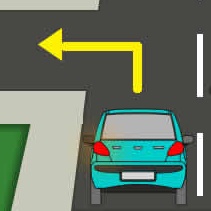
|
1. On roads with one lane for each direction, stay on the axis of the road without entering the opposite direction lane. 2. On 3-lane two-way roads, go to the middle lane. 3. On one-way streets, keep to the left side of the road. 4. At roundabouts, always go around them. 5. Bicycles and mopeds on inter-urban routes will turn from the hard shoulder if there is no designated place for the turn. 6. Turning left is prohibited in places where there is no visibility or where there is a no left turn sign. |
|
Change of direction: - At the same level
- At a different level
|
1. On conventional roads, this can be done both at the same and at a different level. 2. On motorways and dual carriageways, it is done at a different level, through the exits. 3. It should be performed in a manoeuvre without reversing. 4. Places where it is prohibited:
|
Reverse: forbidden on motorways and dual carriageways. On other roads it can be done but only in two ways:
- NO more than 15 metres and DO NOT enter a cross road if using it to park or start.
- You CAN go more than 15 metres and ALSO enter a cross road if used to exit a dead-end street.
4.5 Driving on roundabouts
Vehicles driving around a roundabout have priority over those which are trying to join them.
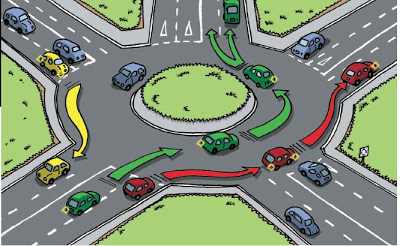
4.6 Immobilization
STOP: Voluntary immobilization that lasts less than 2 minutes and the driver does not abandon the vehicle (but may get out).
PARKING: Voluntary immobilization lasting 2 minutes or more, or lasting less than 2 min and the driver ABANDONS the vehicle.
DETENTION: Involuntary immobilization (breakdown, buckling, jam, feeling unwell, etc.)
4.6.1 Depending on the type of routes:
Motorways and dual carriageways: forbidden to stop and park except in designated places.
Conventional roads: you can stop and park off the roadway and onto the hard shoulder if it is passable. Always on the right side.
Urban roads and cross-town routes: you can stop and park if there is no rule that prohibits it:
- If the road is two-way: On the right side
- If the road is one-way: On both sides
4.6.2 Stopping and parking is prohibited:
- at intersections (unless it does not impede turning)
- in BUS or BIKE lanes or bus stops
- at Pedestrian / cyclist crossings
- in Disabled areas
- if it leaves less than 3 metres for others to pass
- on median strip or central reservation
- if it hampers the merging of traffic
4.6.3 Parking is prohibited:
- In timed zones without a ticket
- On the pavement (UK) / sidewalk (USA) or blocking a garage entrance ford
- In double rows
- In loading and unloading areas
4.6.4 Parking rules:
1. Stop the engine and make sure the vehicle cannot be used without authorization.
2. Engage the handbrake (UK) / parking brake (USA).
3. On uphill gradients, put the vehicle in first gear and into reverse on downhill gradients.
4. If towing a trailer, place chocks or lean the wheels on the kerb (UK) / curb (USA).
4.6.5 In case of emergency:
1. Warning triangle: On two-way roads, place one in front and one behind. On one-way roads, place one behind. They are placed at least 50 metres from the vehicle and so that they are visible from at least 100 metres by other road users.
2. Turn on the hazard warning lights during the day and night.
3. Use emergency posts or call 112.
4. The vehicle should always be towed away on motorways and dual carriageways.

